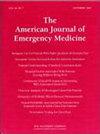F(ab')₂AV 和 FabAV 用于响尾蛇中毒的急性不良反应:一项为期四年的毒物中心研究。
IF 2.7
3区 医学
Q1 EMERGENCY MEDICINE
引用次数: 0
摘要
在美国,每年被响尾蛇咬伤的 Crotalid 人数最多。在美国,目前有两种抗蛇毒血清可用于治疗响尾蛇蛇毒中毒:Crotalidae多价绵羊免疫Fab抗蛇毒血清(CroFab®;FabAV)和Crotalidae马免疫F(ab')₂抗蛇毒血清(ANAVIP®;F(ab')₂AV)。很少有研究对每种抗蛇毒血清的不良反应率进行比较。我们对 2018 年 10 月至 2022 年 8 月期间致电加州毒物控制系统的响尾蛇蛇毒中毒患者进行了回顾性病历审查。其中包括在医疗机构接受两种抗蛇毒血清治疗的患者。同时使用两种抗蛇毒血清治疗的患者不包括在内。记录来自毒物中心电子病历系统。摘录了人口统计学和临床数据。"严重 "不良事件的定义是多器官系统受累、患者气道肿胀和/或血液动力学不稳定。所有其他不良事件均被归类为 "非严重"。共纳入了 481 个病例,其中 360 例接受了 FabAV 治疗,121 例接受了 F(ab')₂AV 治疗。年龄中位数分别为 47 岁和 46 岁,男性分别占 72% 和 73%。两组的临床症状和体征相似。FabAV 组收到的药瓶数量中位数为 6 瓶。F(ab')₂AV 组根据 FabAV 和 F(ab')2AV 的推荐负荷剂量,中位数为 10 瓶。注射抗蛇毒血清后,12 名接受 FabAV 治疗的患者出现了 18 例急性非严重 AE。两名接受 F(ab')₂AV 治疗的患者出现了 2 例急性非严重 AE。皮疹或荨麻疹是两组患者服用抗蛇毒血清后最常见的不良反应。毒物中心记录显示,5 名患者(1.5%)在注射 FabAV 后出现了严重的不良反应,而注射 F(ab')₂AV 后没有出现任何不良反应(p = 0.025)。总体而言,毒物中心的数据表明,使用这两种抗蛇毒血清后的不良反应发生率都很低。由于缺乏一致的时间数据、F(ab')₂AV 队列规模较小、采用回顾性形式以及使用毒物中心数据,我们的研究结果存在局限性。本文章由计算机程序翻译,如有差异,请以英文原文为准。
Acute adverse effects of F(ab’)₂AV and FabAV use for rattlesnake Envenomations: A four-year poison center study
Rattlesnake envenomations account for many of the Crotalid envenomations in the United States annually. Two antivenoms are currently available to treat Crotalid envenomation in this country: Crotalidae-polyvalent ovine immune Fab antivenom (CroFab®; FabAV) and Crotalidae equine immune F(ab’)₂ antivenom (ANAVIP®; F(ab’)₂AV). Few studies have compared the adverse effect rates for each.
We performed a retrospective chart review of rattlesnake envenomations called to the California Poison Control System from October 2018 to August 2022. Those treated at healthcare facilities with either antivenom were included. Those treated with both antivenoms were excluded.
Records were obtained from the poison center electronic medical records system. Demographic and clinical data were abstracted. “Severe” adverse events were defined as multi-organ system involvement, swelling of the patient's airway, and/or hemodynamic instability. All others were categorized as “non-severe.”
A total of 481 cases were included with 360 treated with FabAV and 121 with F(ab’)₂AV. The median age was 47 and 46 years, and 72 % and 73 % were male, respectively. Clinical signs and symptoms of envenomation were similar in each group.
The FabAV group received a median of six vials. The F(ab’)₂AV group received a median of 10 vials, based on the recommended loading doses of FabAV and F(ab’)2AV. Following antivenom administration, 18 individual acute non-severe AEs were reported in 12 FabAV-treated patients. Two acute non-severe AEs were reported in two F(ab’)₂AV-treated patients. Rash or urticaria was the most commonly reported adverse effect in both groups after antivenom administration. Five patients (1.5 %) had severe adverse events reported in the poison center records following FabAV administration, and none were reported following F(ab’)₂AV administration (p = 0.025).
Overall, our poison center data suggests the rate of adverse events is low following the use of either antivenom. Our findings are limited by the lack of consistent timing data, a smaller F(ab’)₂AV cohort, retrospective format, and use of poison center data.
求助全文
通过发布文献求助,成功后即可免费获取论文全文。
去求助
来源期刊
CiteScore
6.00
自引率
5.60%
发文量
730
审稿时长
42 days
期刊介绍:
A distinctive blend of practicality and scholarliness makes the American Journal of Emergency Medicine a key source for information on emergency medical care. Covering all activities concerned with emergency medicine, it is the journal to turn to for information to help increase the ability to understand, recognize and treat emergency conditions. Issues contain clinical articles, case reports, review articles, editorials, international notes, book reviews and more.

 求助内容:
求助内容: 应助结果提醒方式:
应助结果提醒方式:


